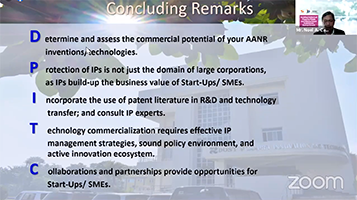 Local startups in the agriculture and aquatic sector can reach out to the Department of Science and Technology (DOST) as its investor of first resort instead of lender of last resort.
Local startups in the agriculture and aquatic sector can reach out to the Department of Science and Technology (DOST) as its investor of first resort instead of lender of last resort.
This was according to Director Noel A. Catibog, of the Technology Transfer and Promotion Division (TTPD) of the Philippine Council of Agriculture, Aquatic and Natural Resources Research and Development (PCAARRD), an agency under the DOST during the webinar of the Intellectual Property Office of the Philippines (IPOPHL) and Japan Patent Office (JPO) titled, “Avoiding Intellectual Property Pitfalls and Utilizing Patent Analytics for Startup Growth.”
Being the initial investor, the government, through technology transfer initiatives, can reap the rewards of R&D investments in the agriculture, aquatic, and natural resources (AANR) sector.
With this support, Catibog said that startups can avoid the common Intellectual Property (IP) pitfalls, which DOST-PCAARRD Innovation and Technology Center or the DPITC addresses.
Common IP pitfalls and how DPITC addresses these
The first most common pitfall is the low level of appreciation of IPs as assets of government institutions. As a response, Catibog said that DOST-PCAARRD developed technology commercialization platforms that advocate IP management and commercialization. These platforms include the IP-Technology Business Management (IP-TBM); the Agri-Aqua Technology Business Incubators (ATBI), and the Science for the Convergence of Agriculture and Tourism (SciCAT) Program to promote farm tourism in the country.
Second is the lack of familiarity with IP or innovation-related laws. According to Catibog, researchers and startups should know these laws as a lot of their work involves IP. To increase the knowledge of researchers and startups about IP, DPITC conducted multiple policy seminar, review, workshop, and advocacies to AANR stakeholders.
“We also advocated and helped our agencies with the help of IPOPHL in crafting institutional IP policies and institutional technology transfer protocols that the researchers and institutions will use in guiding them with their work,” said Catibog.
The third and fourth IP pitfalls were the minimal use of patent literature in packaging R&D proposals and failure to protect inventions as well as limited skills on IP prosecution. To address the third concern, Catibog said that DOST-PCAARRD has incorporated use of patent literature in R&D in technology transfer packaging and prioritization. On the other hand, trainings on IP protection and prosecution to capacitate researchers and startups on IP prosecution were conducted by DPITC.
 The last and the most crucial IP pitfall is the researchers’ reluctance in commercializing their inventions due to limited business acumen. To convince them, DPITC organized a series of technology commercialization and mentorship training and provided them assistance during negotiations. DPITC also provided documents needed to build a startup and assistance in developing business plans, market study, and feasibility study, among others. This year, DPITC also launched the Level-up Assistance Program for Startups or LEAP, which will provide grants to startups that will be adopting locally generated technologies.
The last and the most crucial IP pitfall is the researchers’ reluctance in commercializing their inventions due to limited business acumen. To convince them, DPITC organized a series of technology commercialization and mentorship training and provided them assistance during negotiations. DPITC also provided documents needed to build a startup and assistance in developing business plans, market study, and feasibility study, among others. This year, DPITC also launched the Level-up Assistance Program for Startups or LEAP, which will provide grants to startups that will be adopting locally generated technologies.
Catibog concluded by summarizing the initiatives under the DPITC acronym: Determine and assess the commercial potential of your inventions/technologies; Protection of IPs is not just the domain of large corporations, as IPs build-up the business value of Start-ups/SMEs; Incorporate the use of patent literature in R&D and technology transfer and consult IP experts when the need arises; Technology commercialization requires effective IP management strategies, sound policy environment and an active innovation ecosystem; and Collaboration and partnerships provide opportunities for Start-ups or small and medium enterprises (SMEs).
Niidome Yutaka, Director for Intellectual Property JETRO (Japan External Trade Organization) Singapore and Mr. Jason Loh, Chief Executive Officer (CEO) and founder of Piece Future Pte. Ltd., were among the roster of speakers. The event, which was held on April 22, 2021, registered almost 280 attendees via Zoom and 1,200 Facebook Live viewers.
